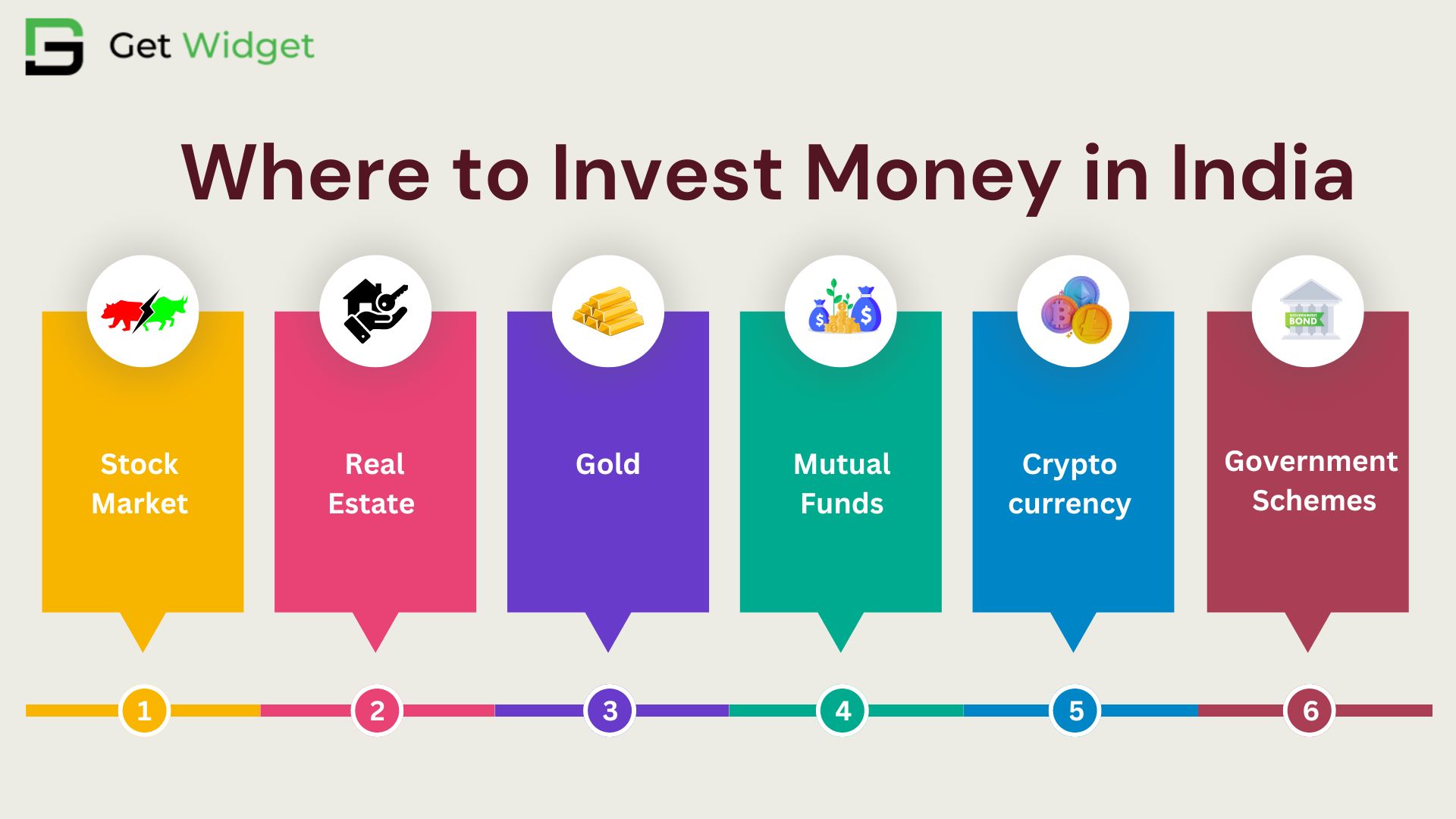India, as one of the world’s fastest-growing major economies, continues to attract both domestic and international investors. Investing your money wisely in this dynamic market can offer significant opportunities for growth and prosperity. As we navigate through the year 2024, it is crucial to understand the current economic and investment climate in the country and make well-informed decisions to maximize returns and mitigate risks. With a diverse range of sectors experiencing rapid expansion, strategic investing of your money in India can yield fruitful results for savvy investors looking to capitalize on the country’s promising growth trajectory.
Why You Invest Your Money in India
Current Economic Landscape
1. India’s GDP Growth Forecast for 2024:
- Moody’s has raised India’s GDP growth forecast for 2024 from 6.1% to 6.8% due to the strong performance of the economy and better-than-expected data in 2023.
- Deloitte has also increased its forecast for India’s growth in 2024 to a range between 6.9% and 7.2% after witnessing impressive GDP numbers in the second quarter of fiscal 2024.
- The International Monetary Fund (IMF) predicts that India’s economy will grow at a rate of 6.5% in the financial year starting April 1, 2024.
2. Implications for Investors:
- The higher GDP growth forecast for 2024 indicates a positive outlook for the Indian economy, which can be encouraging for investors.
- Increased economic growth can lead to higher investment opportunities and potential returns for investors.
- However, it is important for investors to consider other factors such as market conditions, sector performance, and government policies before making investment decisions.
3. Key Sectors Driving Economic Growth:
While specific sectors driving economic growth may vary, some key sectors in India include:
- Information Technology (IT) and Business Process Management (BPM)
- Manufacturing and Industrial sectors
- Services sector, including finance, healthcare, and tourism
- Agriculture and allied industries
These sectors contribute significantly to India’s GDP and have the potential for further growth and investment opportunities.
4. Potential Areas of Concern:
Despite the positive growth forecast, there are some areas of concern that investors should be aware of:
- Inflation: Rising inflation can impact the purchasing power of consumers and affect the overall economy.
- Infrastructure: Adequate infrastructure development is crucial for sustained economic growth. Insufficient infrastructure can hinder business operations and investment opportunities.
- Policy Reforms: Changes in government policies and reforms can have both positive and negative impacts on specific sectors and industries. Investors should stay updated on policy developments and assess their potential effects.
5. Government Policies and Reforms:
Government policies and reforms play a significant role in shaping the investment environment in India. Some key policies and reforms influencing the investment environment include:
- Make in India: A campaign to promote manufacturing and attract foreign direct investment (FDI) in various sectors.
- Goods and Services Tax (GST): A unified tax system aimed at simplifying the tax structure and improving ease of doing business.
- Digital India: An initiative to promote digital infrastructure and technology adoption across sectors.
- Ease of Doing Business: Efforts to streamline regulatory processes and improve the business environment for both domestic and foreign investors.
6. Key Factors to Consider Before Investing:
Before investing in real estate in India, it’s important to consider several key factors, including:
Market Research: Conduct thorough market research to understand demand-supply dynamics, pricing trends, and regulatory factors in the target location.
Legal Due Diligence: Understand the legal framework, land titles, and regulatory compliance to ensure a smooth investment process.
Risk Assessment: Evaluate the risks associated with the investment, including market volatility, liquidity, and potential regulatory changes.
Popular Investment Options: Popular investment options in the Indian real estate market include residential apartments, commercial office spaces, retail properties, and industrial warehouses. Each of these segments offers unique opportunities and challenges, and investors should carefully assess their investment goals and risk tolerance before making a decision.
Where to Invest Money in India [2024 Updated]

That’s why we present to you these 6 investment options in India for financial stability and success:
Stock Market Investments
Analysis of the Current State of the Indian Stock Market
- Performance of major stock indices such as the BSE Sensex and NSE Nifty in 2024.
- Factors influencing stock market movements, including corporate earnings, global cues, and domestic economic indicators.
- Impact of regulatory changes and government policies on the stock market.
Potential Sectors and Companies for Investment in 2024
- Overview of promising sectors such as technology, healthcare, renewable energy, and consumer goods.
- Analysis of specific companies with strong fundamentals and growth potential.
- Consideration of emerging trends and disruptive technologies shaping investment opportunities.
Risks and Opportunities in the Stock Market
- Identification of market risks, including volatility, geopolitical uncertainties, and regulatory changes.
- Opportunities presented by undervalued stocks, IPOs, and M&A activities.
- Importance of diversification and risk management strategies in stock market investments.
By delving into the analysis of the current state of the Indian stock market, highlighting potential sectors and companies for investment, and discussing the associated risks and opportunities, investors can gain valuable insights to make informed decisions in 2024.
Real Estate Investments
Overview of the Real Estate Market in India
- Current trends in residential, commercial, and industrial real estate segments.
- Price movements and demand-supply dynamics in key metropolitan areas and emerging cities.
- Regulatory changes and policy initiatives impacting the real estate sector.
Emerging Trends and Growth Areas for Real Estate Investment
- Analysis of emerging trends such as co-living spaces, warehousing, and affordable housing.
- Growth potential in specific micro-markets and upcoming development corridors.
- Impact of technological advancements and sustainability initiatives on real estate investment.
Factors to Consider Before Investing in Real Estate
- Legal and regulatory considerations, including property rights, land titles, and zoning regulations.
- Assessment of rental yields, capital appreciation potential, and liquidity of the investment.
- Due diligence on developer reputation, project quality, and market demand for the property type.
By providing an overview of the real estate market in India, highlighting emerging trends and growth areas for investment, and outlining the key factors to consider before investing in real estate, investors can gain valuable insights into making informed decisions in this asset class.You must know best investment apps in India
Mutual Funds and SIPs
Exploring the Benefits of Mutual Funds and Systematic Investment Plans (SIPs)
- Explanation of mutual funds as investment vehicles pooling money from multiple investors to invest in diversified portfolios.
- Advantages of mutual funds, including professional fund management, diversification, and liquidity.
- Definition and benefits of SIPs as a disciplined approach to investing in mutual funds through regular, periodic contributions.
Top-Performing Mutual Funds in 2024
- Analysis of top-performing mutual funds across categories such as equity, debt, and hybrid funds.
- Evaluation of fund performance based on factors like risk-adjusted returns, consistency, and expense ratios.
- Consideration of funds with a track record of delivering value to investors over the long term.
How SIPs Can Be a Viable Option for Long-Term Wealth Creation
- Illustration of the power of compounding through regular investments in SIPs over the long term.
- Benefits of rupee cost averaging in volatile markets and the potential for higher returns.
- Comparison of SIPs with lump-sum investments and the impact on portfolio returns and risk management.
By exploring the benefits of mutual funds and SIPs, showcasing top-performing mutual funds in 2024, and highlighting how SIPs can be a viable option for long-term wealth creation, investors can gain insights into leveraging these investment avenues for their financial goals.
Gold and Precious Metals
Role of Gold as an Investment in India
- Historical significance of gold as a store of value and a hedge against inflation.
- Cultural and traditional relevance of gold in Indian society and its impact on investment patterns.
- Analysis of various forms of gold investment, including physical gold, gold ETFs, and sovereign gold bonds.
Outlook for Investing in Precious Metals in 2024
- Assessment of the global economic and geopolitical factors influencing the prices of precious metals.
- Market trends and demand-supply dynamics for metals like silver, platinum, and palladium.
- Impact of macroeconomic indicators on the performance of precious metals as an asset class.
Hedging Strategies Using Gold and Other Precious Metals
- Explanation of how investors can use gold and other precious metals to hedge against currency devaluation and market volatility.
- Comparison of different hedging instruments such as futures, options, and commodity-based ETFs.
- Consideration of portfolio diversification and risk management through exposure to precious metals.
By discussing the role of gold as an safe investment option in India, providing an outlook for investing in precious metals in 2024, and exploring hedging strategies using gold and other precious metals, investors can gain valuable insights into incorporating these assets into their investment portfolios for diversification and risk management.
Cryptocurrency and Digital Assets
Impact of Cryptocurrency Regulations on Investment Decisions
- Analysis of the evolving regulatory landscape for cryptocurrencies in India and its influence on investor sentiment.
- Consideration of the impact of regulatory clarity on the adoption and investment option in digital assets.
- Examination of the taxation framework and legal considerations impacting cryptocurrency investments.
Potential for Growth and Risks Associated with Investing in Digital Assets
- Assessment of the growth potential of cryptocurrencies and blockchain technology in the Indian market.
- Analysis of the risks associated with investing in digital assets, including price volatility, security concerns, and regulatory uncertainties.
- Consideration of factors such as market liquidity, technological developments, and adoption trends influencing the investment landscape.
Different Investment Strategies for Cryptocurrency in 2024
- Exploration of best investment option strategies such as buy-and-hold, dollar-cost averaging, and active trading in the cryptocurrency market.
- Discussion of staking, yield farming, and decentralized finance (DeFi) as alternative investment avenues within the digital asset space.
- Evaluation of risk management techniques and portfolio allocation strategies specific to cryptocurrency investments.
By addressing the impact of cryptocurrency regulations on best investment decisions, assessing the potential for growth and associated risks with investing in digital assets, and exploring different investment strategies for cryptocurrency in 2024, investors can gain insights into navigating the dynamic landscape of digital asset investment options in India.
Government Schemes and Bonds
Overview of Government-Backed Investment Schemes
- Explanation of various government-backed investment schemes such as Public Provident Fund (PPF), National Savings Certificate (NSC), and Sukanya Samriddhi Yojana.
- Comparison of the features, interest rates, and lock-in periods of different schemes to assist investors in making informed decisions.
- Emphasis on the safety and reliability of government-backed schemes in providing stable returns.
Analysis of Bond Markets and Fixed-Income Securities in India
- Examination of the bond market landscape in India, including government bonds, corporate bonds, and municipal bonds.
- Discussion of the risk-return profile of fixed-income securities and their role in diversifying investment portfolios.
- Consideration of factors influencing bond yields, such as interest rate movements and credit ratings.
Tax Implications and Benefits of Investing in Government Schemes and Bonds
- Explanation of the tax benefits associated with investments in government schemes, including deductions under Section 80C of the Income Tax Act.
- Analysis of the tax treatment of interest income from bonds and fixed-income securities.
- Exploration of the role of government bonds in providing a reliable source of income and capital preservation for investors.
By providing an overview of government-backed investment schemes, analyzing bond markets and fixed-income securities in India, and discussing the tax implications and benefits of investing in government schemes and bonds, investors can gain a comprehensive understanding of the opportunities available in the fixed-income investment landscape.
GetWidget – Your Partner in Mobile App Development!
Looking to bring your unique app idea to life? At Getwidget, we specialize in crafting custom mobile applications tailored to your specific needs. Whether it’s iOS, Android, or cross-platform development, our team is dedicated to turning your vision into a reality.
Reach out to us today and let’s discuss how we can bring your app idea to fruition!
1. Where to invest money in India for secure returns?
In India, traditional investment options such as fixed deposits, government bonds, and savings accounts are commonly regarded as secure avenues to invest money. These low-risk options are well-suited for safeguarding your initial investment amount while providing a stable return.
2. How do I decide where to invest money based on my risk tolerance?
When deciding where to invest money based on your risk tolerance, consider the following steps:
Assess Your Risk Tolerance: Understand how comfortable you are with taking risks in investments. Are you willing to accept potential losses for higher returns, or do you prefer stability?
Diversification: Spread your investments across different asset classes (stocks, bonds, real estate) to manage risk. The mix of investments should align with your risk tolerance.
Time Horizon: Determine when you will need the money. Longer time horizons can accommodate riskier investments since you have more time to recover from market fluctuations.
Investment Goals: Define your financial goals (retirement, education, buying a house) and match them with appropriate investment options.
Consult a Financial Advisor: Seek advice from a professional to help you understand your risk profile and recommend suitable investment strategies.
By considering these factors, you can make informed decisions on where to invest your money based on your risk tolerance.
3. Are there any tax-saving investment options available in India?
There are several tax-saving investment options available in India. Some popular options include:
Equity Linked Saving Scheme (ELSS): A mutual fund that primarily invests in equities, offering tax benefits under Section 80C of the Income Tax Act.
Public Provident Fund (PPF): A long-term investment scheme offered by the government, providing tax benefits on both the investment amount and the interest earned.
National Savings Certificate (NSC): A fixed-income investment scheme with a lock-in period of 5 years, offering tax benefits under Section 80C.
4. How can I diversify my investment portfolio effectively in the Indian market?
Diversifying your investment portfolio effectively in the Indian market involves spreading your investments across different asset classes to reduce risk. Here are some strategies to diversify your portfolio:
Asset Allocation: Allocate your investments across various asset classes such as equities, fixed income, real estate, and commodities based on your risk tolerance and investment goals.
Invest in Mutual Funds: Mutual funds pool money from multiple investors to invest in a diversified portfolio of securities. Choose funds that invest in different sectors and market caps to spread risk.
Sector Diversification: Invest in different sectors of the economy to reduce concentration risk. Consider sectors like technology, healthcare, finance, and consumer goods.
Geographic Diversification: Consider investing in international funds or companies with global exposure to diversify geographically and reduce dependency on the Indian market.
Invest in Different Investment Vehicles: Apart from stocks and mutual funds, explore other investment options like bonds, real estate investment trusts (REITs), and gold to further diversify your portfolio.
Regular Portfolio Review: Monitor your investments regularly and rebalance your portfolio to maintain the desired asset allocation and risk level.
Risk Management: Consider using tools like stop-loss orders and setting a diversified stop-loss limit for your portfolio to manage downside risk.
By following these strategies, you can effectively diversify your investment portfolio in the Indian market and potentially reduce overall risk while aiming for better returns.



